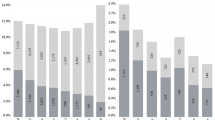Abstract
This study examines the proposition that mass higher education is, in practice, less a network of more or less homogeneous activities than a series of concentric circles in which elite institutions remain at the centre, but are surrounded by increasingly wide bands of universities and colleges, that are less and less likely to set graduates on the road to elite status the further they are from the centre. After a brief review of the classical and subsequent literature on elites and elite formation, the empirical study uses data from the very long established annual publication Who’s Who to make a quantitative analysis of the higher education background of all 120,000 Who’s Who entries born in the twentieth century. It finds that Oxford and Cambridge remained the dominant route to elite status throughout the century, though their share fell from about a third to about a quarter of the total. There were big rises in the contribution of other leading universities that have come to be known as the ‘Russell Group’. An analysis by main occupational categories shows that the political elite broadened its educational catchment area more than other groups. The so-called ‘public’ (i.e. independent) secondary schools also continued to make contributions much larger than their numbers warrant. The main conclusions are that Bourdieu’s notion of ‘symbolic capital’ offers a useful contribution to the interpretation of the continued dominance of well-known high status universities, and that while there was considerable change throughout the century, in general it followed the British tradition of being evolutionary and slow. In policy terms it concluded that the present government is justified in seeking both to widen participation generally and simultaneously to increase the number of people from modest economic and social backgrounds who attend the high prestige universities.









Similar content being viewed by others
Notes
Some individuals are classified as belonging to two or more groups because they have achieved distinction in more than one area of activity.
The 2008 figure seems to be a bit of an aberration with a sudden big rise in the Oxbridge figure.
This figure omits those who succeeded to their titles below the age of 20 before which they cannot be expected to have had some higher education.
Preparation for elite status is far from uniform amongst these schools. Eton easily tops the list with over 6,000 mentions, more than three times as many as any of the other schools. At the other extreme nearly 100 of the schools had fewer than 100 mentions over the twentieth century.
This is different from career experiences in several universities, though a few entries seem to fudge the two.
References
Bennett, T. (2005). Elite. In T. Bennett, L. Grossberg, M. Morris, & R. Williams (Eds.), New keywords: A revised vocabulary of culture and society. Malden, Mass: Blackwell.
Bourdieu, P. (1984). Distinction: A social critique of the judgement of taste. London: Routledge & Kegan Paul.
Bourdieu, P. (1986). The forms of capital. In J. G. Richardson (Ed.), Handbook for theory and research for the sociology of education. Westport, Conn: Greenwood Press.
Bourdieu, P. (1993). The field of cultural production: Essays on art and literature. Cambridge: Polity.
Burnham, J. (1942). The managerial revolution. Bloomington: Indiana University Press.
Drysdale, R. (2007). Over ancient ways: A portrait of St Peter’s school, York. London: Third Millennium.
Edwards, D. L. (1957). A history of the King’s school Canterbury. London: Faber and Faber Ltd.
Gellert, C. (1999). Changing paradigms of university education in Europe. In C. Gellert (Ed.), Innovation and adaptation in higher education: The changing conditions of advanced teaching and learning in Europe. London: Jessica Kingsley.
Giddens, A., & Stanworth, P. (Eds.). (1974). Elites and power in British society. Cambridge: Cambridge University Press.
Gourlay, A. B. (1951). A history of Sherborne school. Winchester: Warren.
Michels, R. (1962). Political parties: A sociological study of the oligarchical tendencies of modern democracy. New York: Free Press.
Morgan, H. P. (1990). Sponsored and Contest Mobility Revisited: an examination of Britain and the USA today. Oxford Review of Education, 16(1), 39–54. doi:10.1080/0305498900160104.
Mosca, G. (1939). The ruling class. New York: Mc Graw-Hill.
Pareto, V. (1935). The mind and society. Harcourt: Brace.
Public Schools. (2008). Guide at http://www.publicschools.co.uk/guide.htm.
Pusser, B., & Ordorica, I. (2001). Bringing political theory to university governance: A comparative analysis of governing boards at the Universidad Nacional Autonoma de Mexico and the University of California. In J. C. Smart (Ed.), Higher education: Handbook of theory and research (Vol. XVI). Bronx: Agathon Press.
Sampson, A. (1965). Anatomy of Britain today. London: Hodder and Stoughton.
Sampson, A. (1982). The changing anatomy of Britain. London: Hodder and Stoughton.
Sutton Trust. (2009). The educational backgrounds of leading lawyers, journalists, vice chancellors, politicians, medics and chief executives (The Sutton Trust submission to the Milburn Commission on access to the professions).
Trow, M. (1974). Problems in the transition from elite to mass higher education. Policies for higher education. Paris: OECD.
Turner, R. H. (1960). Sponsored and contest mobility and the school system. American Sociological Review, 25(6), 855–862. doi:10.2307/2089982.
Weber, M. (1946/1958). From Max Weber. Translated and edited by H. H. Gerth & C. Wright Mills. New York: Galaxy.
Who’s Who. (2008). London: A C Black. Online edition at http://www.ukwhoswho.co.uk.
Wright Mills, C. (1958). The power elite. Oxford: Oxford University Press.
Author information
Authors and Affiliations
Corresponding author
Appendix
Rights and permissions
About this article
Cite this article
Williams, G., Filippakou, O. Higher education and UK elite formation in the twentieth century. High Educ 59, 1–20 (2010). https://doi.org/10.1007/s10734-009-9229-6
Received:
Accepted:
Published:
Issue Date:
DOI: https://doi.org/10.1007/s10734-009-9229-6




